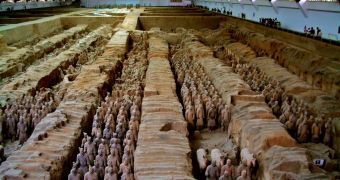In 1974, while digging for a well, the Chinese farmers from a village in the Shaanxi province discovered several terracotta statues. They were the first of thousands of statue-soldiers of an army buried in the tomb of the Chinese emperor Qin Shihuang, who died 2,200 years ago.
The 8,099 soldiers, 300 horses and 200 chariots guard the tomb of the emperor. The combatants were placed in 40 lines, like in a parade, on a length of 200 m (666 ft). The height of each statue was of 1.81-1.91 m, but this does not reflect reality, as the terracotta soldiers were made taller than living counterparts.
Qin Shihuang was the ruler of the Qin kingdom since 246 BC. Until 221 BC, he finished the annexation of the other Chinese kingdoms (Han, Zhao, Wei, Qi and Yan), unifying China for the first time, after long bloody wars. Qin proclaimed himself emperor and ruled until his death in 210 BC. The name of "China" comes from Qin, the dynasty he founded (the Chinese call themselves "Han"). In 214 BC, Qin Shihuang started the construction of the Great Chinese Wall. China was divided in 36 provinces, ruled by a governor and military commander, all responding directly to the emperor.
No wonder, such a ruler wanted to be accompanied by a whole army in the other world, even if this army could only be made of statues. Initially, the fighters in the emperor's tomb were protected by wooden plates. In 206 BC, 4 years after Shi Huang Di's death, a great revolt of the peasantry started, when the revolted villagers violated and plundered the tomb of the emperor, to get to the goods buried there (lances, swords, crossbows, plates and dishes, and so on). After the devastation, the tomb was burned, that's why the wooden roofs crumbled burned over the soldier lines, crushing part of the statues.
Chinese researchers managed to remake over 1,000 statues starting from the broken pieces. Finishing the procedure will require decades. The statues come with precious information about the weaponry of the age and the materials used for their fabrication. The traces of paint found on some statues point to the fact that, initially, all the statues were completely painted.
The tomb of the emperor was built by thousands of workers and craftsmen (stone carvers, carpenters, potters). If the arms, feet and torso of the soldiers are similar, being made of clay, heads are different. The hair and faces were poured in different molds, achieving diversified combinations. Each fighter had a different physiognomy, given by the eye location, nose, mustaches and other details. Many specialists believe that the faces mimicked those of the real soldiers in the imperial army. The parts of a statue were assembled, than the statue was burned in kilns. Lately, the statue was painted.
The army is now protected by a 16,000 square meters vault, opened for tourists. Meanwhile, the statues face another issue: the heat and humidity expose them to the attack of molds. That's why some special pieces, like war chariots, are placed behind show cases.

 14 DAY TRIAL //
14 DAY TRIAL //